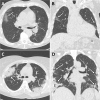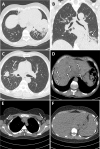Accuracy and Reproducibility of Low-Dose Submillisievert Chest CT for the Diagnosis of COVID-19
- PMID: 33778576
- PMCID: PMC7233439
- DOI: 10.1148/ryct.2020200196
Accuracy and Reproducibility of Low-Dose Submillisievert Chest CT for the Diagnosis of COVID-19
Abstract
Purpose: To demonstrate the accuracy and reproducibility of low-dose submillisievert chest CT for the diagnosis of coronavirus disease 2019 (COVID-19) infection in patients in the emergency department.
Materials and methods: This was a Health Insurance Portability and Accountability Act-compliant, institutional review board-approved retrospective study. From March 14 to 24, 2020, 192 patients in the emergency department with symptoms suggestive of COVID-19 infection were studied by using low-dose chest CT and real-time reverse transcription polymerase chain reaction (RT-PCR). Image analysis included the likelihood of COVID-19 infection and the semiquantitative extent of lung involvement. CT images were analyzed by two radiologists blinded to the RT-PCR results. Reproducibility was assessed using the McNemar test and intraclass correlation coefficient. Time between CT acquisition and report was measured.
Results: When compared with RT-PCR, low-dose submillisievert chest CT demonstrated excellent sensitivity, specificity, positive predictive value, negative predictive value, and accuracy for diagnosis of COVID-19 (86.7%, 93.6%, 91.1%, 90.3%, and 90.2%, respectively), in particular in patients with clinical symptoms for more than 48 hours (95.6%, 93.2%, 91.5%, 96.5%, and 94.4%, respectively). In patients with a positive CT result, the likelihood of disease increased from 43.2% (pretest probability) to 91.1% or 91.4% (posttest probability), while in patients with a negative CT result, the likelihood of disease decreased to 9.6% or 3.7% for all patients or those with clinical symptoms for >48 hours. The prevalence of alternative diagnoses based on chest CT in patients without COVID-19 infection was 17.6%. The mean effective radiation dose was 0.56 mSv ± 0.25 (standard deviation). Median time between CT acquisition and report was 25 minutes (interquartile range: 13-49 minutes). Intra- and interreader reproducibility of CT was excellent (all intraclass correlation coefficients ≥ 0.95) without significant bias in the Bland-Altman analysis.
Conclusion: Low-dose submillisievert chest CT allows for rapid, accurate, and reproducible assessment of COVID-19 infection in patients in the emergency department, in particular in patients with symptoms lasting longer than 48 hours. Chest CT has the additional advantage of offering alternative diagnoses in a significant subset of patients.© RSNA, 2020.
2021 by the Radiological Society of North America, Inc.
Conflict of interest statement
Disclosures of Conflicts of Interest: A. Dangis disclosed no relevant relationships. C.G. disclosed no relevant relationships. Y.D.B. disclosed no relevant relationships. L.J. disclosed no relevant relationships. H.V. disclosed no relevant relationships. D.O. disclosed no relevant relationships. M.G. disclosed no relevant relationships. M.V.R. disclosed no relevant relationships. J.F. disclosed no relevant relationships. A. Demeyere disclosed no relevant relationships. R.S. disclosed no relevant relationships.
Figures




References
-
- World Health Organization . Coronavirus disease (COVID-19) outbreak. https://www.who.int/emergencies/diseases/novel-coronavirus-2019. 2020. Accessed April 15, 2020.
LinkOut - more resources
Full Text Sources

